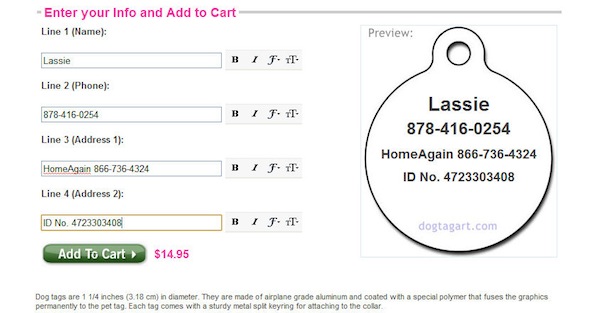by Clark Mackey
I was in the utility room when my cell phone rang. On the other end I heard, "Hi, I think I have your dog. His tag says Poet and he ran up to me on the sidewalk." Sure enough, I found my front door ajar and, about 100 yards away, someone was walking towards me on the other side of the street with my dog in her arms. Happiness and anxiety hit me all at the same time.
I'd had my pet microchipped as a puppy, but I've come to realize that the microchip is not enough. Each time my dog has wandered, it has put some pretty intense, if brief, pressure on my family. The sooner he's safe, the better off we all are, including the dog! Here's the sytem we use to keep the little guy safe with a minimum of hassle:
- 1. Get your pet microchip implanted at your vet. Pay the fee and fill out the form on the spot. We used HomeAgain. Their service came with it's own generic dog tag - more on that below.
- 2. Buy one of Dog Tag Art's pet id tags. It holds more text than any other tags we have seen and it looks great.
- 3. Combine your dog's name, your phone number, the microchip phone number, and the microchip ID number all on one tag (see picture).
- 4. Have your dog wear one of Dog Tag Art's personalized pet tags and put the generic pet microchip tag in the file with your other pet information, just in case.
This system has meant quick phone calls to our local number every time the dog has wandered. When your pet is lost, the safest turn of events is for another person who finds the pet to reach you as soon as possible - so our number goes on the tag first.

But the microchip information gives the good samaritan a fallback number. By placing all the information on one tag, we've cut down on the number of tags our dog has to wear. And having the microchip number on the tag has another important effect: It acts as a deterrent to would be dognappers. There is no doubt, when you examine my dog's tag, that someone is going to be looking for him and that he has been chipped. And that encourages people to do the right thing and call one of the numbers on the tag.
A microchipped pet without a tag means that only a vet or humane society with a scanner is likely to be able to find you, and only if they follow through and scan the pet. For me, that means it is essential to combine the microchip with a good dog tag.
Here are some additional resources for anyone thinking about a microchip for their dog:
- 1. Wikipedia article about pet microchip technology.
- 2. Test your chip with the universal lookup service.
- 3. The Humane Society of the United States' position on pet microchips.

